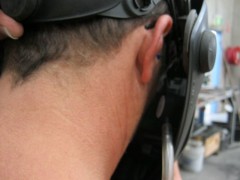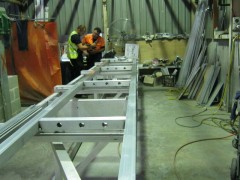Welding Fume
What is Welding Fume
The process of welding essentially melts and joins metals together. It is this process which occurs at very high temperatures that volatilizes metal and other constituents, leading to a thermally generated plume of material, being a fume.
What are the Health Effects of Exposure to Welding Fume
The health effects of welding fume can vary considerably. This is due to the health effects being dependant on the particular metal, fluxes and cleaning agents that may be present within the welding process. In general the most common disease and health effects of welding dust, fume vapour and gas include:
- Pneumoconiosis
- Cancer
- Occupational asthma
- Asphyxiation
- Upper respiratory tract irritation
- Central nervous system (CNS) effects
- Lung damage
- Emphysema
- Skin irritation
- Headaches
- Chest pain
- Metal fume fever
It should be noted that in general a dose-response relationship ensues; as the exposure to the worker of the hazardous fume increases (dose), the risk of the health effect increases (response). As the dose determines the risk, the term exposure standard is introduced whereby it is a limit where it is believed that the hazard will not adversely affect a person working an 8 hour shift, 5 times a week for 52 weeks of the year, for 40 years of their life. However, there still is the possibility of sysergestic effects and confounding factors such as smoking and individual susceptibilities may arise in health effects to workers below the exposure standard.
What is the Legislation relating to Welding Fume
The NSW Work Health and Safety Regulation 2011 (WHS Reg) prescribe specific duties in relation to exposure standards for specific chemicals and mixtures at Chapter 3, Part 3.2 Division 7 Managing risks from airborne contaminants. WHS Regulation 49 requires a Person Conducting a Business or Undertaking (PCBU) at a workplace to ensure that the airborne concentration of welding fume does not exceed the exposure standard. WHS Regulation 50 requires that atmospheric testing is carried out to confirm the compliance with the exposure standard for welding fume.
How do you Test for Welding Fume
Personal air monitoring is generally undertaken over a representative period of time undertaken to Australian Standard AS 3640-2009 Workplace atmospheres – Method for sampling and gravimetric determination of inhalable dust using IOM sampling heads with flow rate of 2.0 L/min.
The samples are then analysed by direct determination of elements by X-Ray Fluorescence Spectrometry and for gravimetric weight.
What is the Exposure Standard for Welding Fume
The exposure standard refers to the publication by Work Safe Australia “Workplace Exposure Standard for Airborne Contaminants” with the Date of Effect being 22 December 2011. Work Safe Australia note that “exposure standards do not represent a fine dividing line between a healthy and unhealthy work environment. Natural biological variation and the range of individual susceptibilities mean that a small number of people might experience adverse health effects below the exposure standard.
The American Governmental Congress of Industrial Hygienists (ACGIH) however recommends a Threshold Limit Value (TLV) Time Weighted Average (TWA) of 5 mg/m3 for welding fume, on the assumption that there are no highly toxic constituents.; However in Australia, there is no specific exposure standard for welding fume This is due to the fume being a combination of the metals and filler material being molten together along with cleaning and fluxing agents present. Each metal or material within the process of welding will generally have its own exposure standard.
As a result, the individual welding fume constituents as well as the total fume concentration should be considered.




